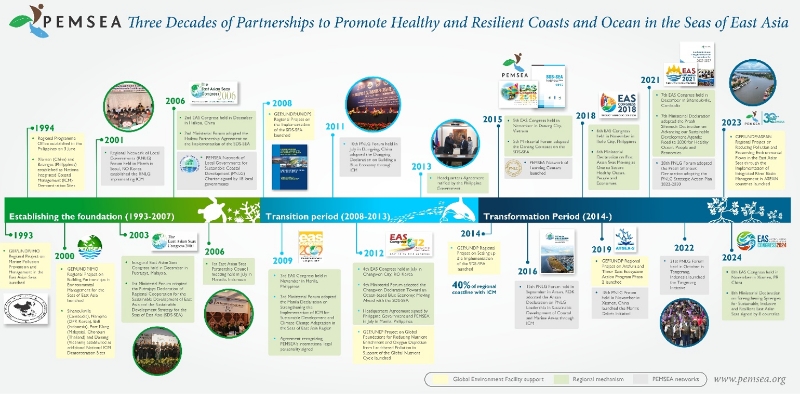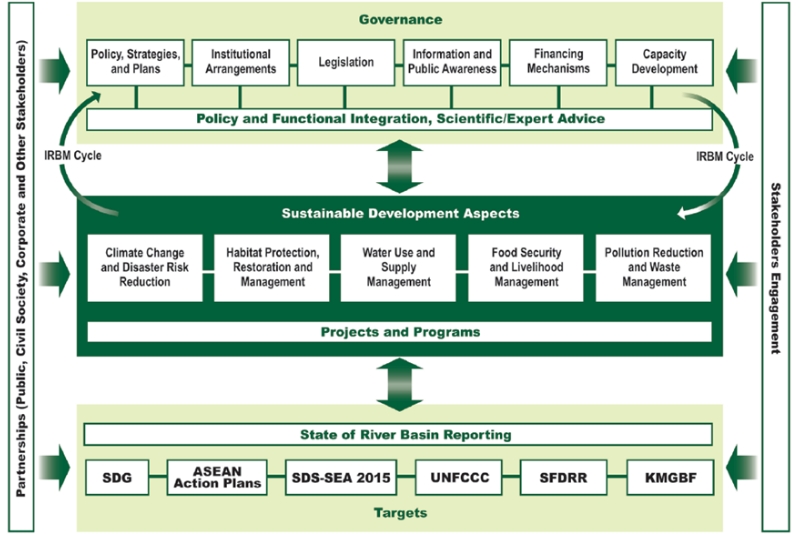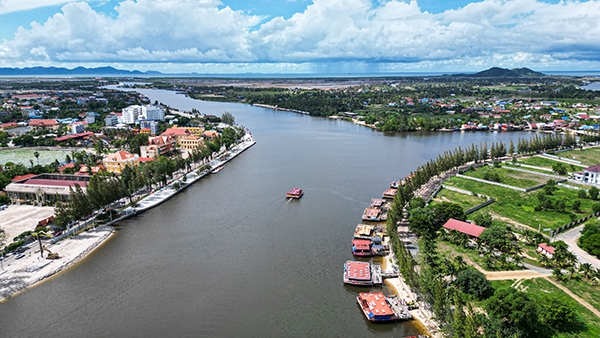Ocean Newsletter
No.588 February 5, 2025
-
Transformative Solutions for Advancing Sustainable Water and Ocean Governance in East Asia
Nancy BERMAS (Regional Project Manager, GEF/UNDP/ASEAN Integrated River Basin Management Project, PEMSEA Resource Facility)
Recognized as a regional model for water and ocean governance, the Partnerships in Environmental Management for the Seas of East Asia (PEMSEA) evolved from a long-running project-based entity into a self-sustaining international organization with legal personality with a mission to foster and sustain healthy and resilient coasts and ocean, communities, and economies at regional, national and local levels across the East Asian Seas (EAS) through integrated management solutions and partnerships under the framework of the Sustainable Development Strategy for the Seas of East Asia (SDS-SEA) that 14 countries in the EAS region have adopted.
-
The Need for Marine Spatial Planning: Global Trends and Japan's Future
WAKITA Kazumi (Professor, School of Marine Science and Technology, Tokai University)
Future oriented (marine) zoning maps, which are the result of marine spatial planning, will not only be useful for fair and efficient responses to new uses such as offshore wind power generation, but after the BBNJ Agreement comes into effect and protected areas are established in the areas beyond national jurisdiction it will also be necessary for considering consistency with the zoning maps of countries with adjacent EEZs. In order to discuss the use and conservation of the entire world's oceans on an equal footing with other countries, it is hoped that Japan will also engage in marine spatial planning that includes its EEZ.
-
The Larike Village Giant Eels Protected Area And How It Might Serve As A Model For The Region’s Sustainable Development
B.G. HUTUBESSY (MSc, Department of Aquaculture, Faculty of Fisheries and Marine Science, Pattimura University), J.W. MOSSE (Professor, Department of Aquaculture, Faculty of Fisheries and Marine Science, Pattimura University)
Larike Village, located in Indonesia, is renowned for its unique conservation efforts, particularly the protection of its giant eels. The Larike Village Giant Eels Protected Area is an example of community-based conservation, where local communities play a crucial role in preserving biodiversity and promoting sustainable development.
-
Energy Transition in Pacific Small Island Developing States (PSIDS) –OTEC and a “PALM Hybrid Model”
T. Suka MANGISI (Ambassador, the Kingdom of Tonga to Japan / PICAG Chairperson), Yukino SAIGO (Former Intern Advisor, the Embassy of the Kingdom of Tonga to Japan / Student, School of International and Area Studies, Tokyo University of Foreign Affairs)
It is important for Pacific Small Island Developing States (PSIDS) to realize the transition to renewable energy. In the Pacific Islands, there is great potential for ocean thermal energy conversion (OTEC), which takes advantage of the ocean's characteristics, but in the short term the need is clear for distributed renewable energy sources_ including OTEC, such as solar and wind power, as well as batteries, in what might be called the "PALM hybrid model." Sharing Japan's "technology, know-how, and funds" is the key to solving the issue of development costs.
Transformative Solutions for Advancing Sustainable Water and Ocean Governance in East Asia
KEYWORDS
regional mechanism/integrative/replication and upscaling
Nancy BERMAS (Regional Project Manager, GEF/UNDP/ASEAN Integrated River Basin Management Project, PEMSEA Resource Facility)
Recognized as a regional model for water and ocean governance, the Partnerships in Environmental Management for the Seas of East Asia (PEMSEA) evolved from a long-running project-based entity into a self-sustaining international organization with legal personality with a mission to foster and sustain healthy and resilient coasts and ocean, communities, and economies at regional, national and local levels across the East Asian Seas (EAS) through integrated management solutions and partnerships under the framework of the Sustainable Development Strategy for the Seas of East Asia (SDS-SEA) that 14 countries in the EAS region have adopted.
Imperatives of Regional Cooperation and Partnerships for the EAS: Institutionalizing PEMSEA
PEMSEA’s story started in the early 1990s in response to addressing the unsustainable patterns of growth and development that continued to compromise the health and integrity of the coastal and marine ecosystems hosted by its 235,000 km of coastline and 7 million square kilometers of sea area comprising six sub-regional large marine ecosystems (i.e., Yellow Sea, East China Sea, South China Sea, Sulu-Celebes Sea, Indonesian Sea and Gulf of Thailand). As an economically dynamic, ecologically interconnected and highly diverse, and socio-culturally rich region and where the livelihood of the estimated 60 percent of its population living within 100 km of its coastline is reliant on the goods and services that the coastal and marine ecosystems provide, the creation of PEMSEA is seen as imperative.
In 2003, 12 PEMSEA countries (i.e., Brunei Darussalam; Cambodia; China; DPR Korea; Indonesia; Japan; Malaysia; Philippines; RO Korea; Singapore; Thailand; and Vietnam) adopted the SDS-SEA with the signing of the Putrajaya Declaration at the First Ministerial Forum of the EAS Congress in Putrajaya, Malaysia. Lao PDR and Timor-Leste adopted the SDS-SEA in 2006 bringing the countries committed to implement the strategy to 14.
The SDS-SEA serves as an overarching regional strategy and framework for action that addresses the identified threats, protect the ecological, socioeconomic and cultural values and promote cooperation and partnerships among the PEMSEA country and non-country partners and other key stakeholders to achieve the shared vision of healthy ocean, people and economies utilizing integrated management approaches [i.e., integrated coastal management (ICM), integrated river basin management (IRBM), integrated water resources management (IWRM), marine spatial planning (MSP)] as delivery mechanisms at national and local levels.
In 2006, PEMSEA was formally recognized as the regional coordinating mechanism for the SDS-SEA with the signing of the Haikou Partnership Agreement during the Second Ministerial Forum of the 2006 EAS Congress in Haikou, China, outlining PEMSEA’s regional governance mechanism[1].
Over the past three decades, PEMSEA’s remarkable evolution from a long-running project-based entity receiving four cycles of funding support from the Global Environment Facility (GEF) into a self-sustaining international organization with legal personality and built based on the spirit of cooperation and partnerships outside the legally binding convention process has been well documented and recognized as a regional model for water and ocean governance. PEMSEA’s international legal personality enabled it to contract and directly receive funds from various donors, in addition to GEF, and manage the funds to develop and implement coastal and ocean governance programs in support of the SDS-SEA[2].
PEMSEA celebrated its 30th anniversary in 2023. Through the PEMSEA Resource Facility (PRF), it now delivers integrated management solutions to its partners at regional, national and local levels through a set of advisory, technical, project management and secretariat services to support the identified priorities and plans of action for sustainable development.
In 2003, 12 PEMSEA countries (i.e., Brunei Darussalam; Cambodia; China; DPR Korea; Indonesia; Japan; Malaysia; Philippines; RO Korea; Singapore; Thailand; and Vietnam) adopted the SDS-SEA with the signing of the Putrajaya Declaration at the First Ministerial Forum of the EAS Congress in Putrajaya, Malaysia. Lao PDR and Timor-Leste adopted the SDS-SEA in 2006 bringing the countries committed to implement the strategy to 14.
The SDS-SEA serves as an overarching regional strategy and framework for action that addresses the identified threats, protect the ecological, socioeconomic and cultural values and promote cooperation and partnerships among the PEMSEA country and non-country partners and other key stakeholders to achieve the shared vision of healthy ocean, people and economies utilizing integrated management approaches [i.e., integrated coastal management (ICM), integrated river basin management (IRBM), integrated water resources management (IWRM), marine spatial planning (MSP)] as delivery mechanisms at national and local levels.
In 2006, PEMSEA was formally recognized as the regional coordinating mechanism for the SDS-SEA with the signing of the Haikou Partnership Agreement during the Second Ministerial Forum of the 2006 EAS Congress in Haikou, China, outlining PEMSEA’s regional governance mechanism[1].
Over the past three decades, PEMSEA’s remarkable evolution from a long-running project-based entity receiving four cycles of funding support from the Global Environment Facility (GEF) into a self-sustaining international organization with legal personality and built based on the spirit of cooperation and partnerships outside the legally binding convention process has been well documented and recognized as a regional model for water and ocean governance. PEMSEA’s international legal personality enabled it to contract and directly receive funds from various donors, in addition to GEF, and manage the funds to develop and implement coastal and ocean governance programs in support of the SDS-SEA[2].
PEMSEA celebrated its 30th anniversary in 2023. Through the PEMSEA Resource Facility (PRF), it now delivers integrated management solutions to its partners at regional, national and local levels through a set of advisory, technical, project management and secretariat services to support the identified priorities and plans of action for sustainable development.

Figure 1. shows a snapshot of PEMSEA’s governance and institutional transformation that has been guided and supported by the series of Ministerial Declarations adopted during the Ministerial Forums of the EAS Congresses that set targets and direction for the partnership.
Common Framework for Integration, Replication and Scaling up
PEMSEA pioneered the development and implementation of government-led ICM programs across East Asia. What started as pilot demonstration projects in 1994 to develop, verify and demonstrate a suitable working model in two ICM sites in China and the Philippines has paved the way for the refinement of the ICM framework and process and its eventual scaling up covering and estimated 40 percent of the coastlines of 12 countries in East Asia in 2020.
Practical experience in ICM application in the region has led to the formulation of a generic Framework for Sustainable Development of Coastal Areas, which is also being applied for the implementation of conceptually similar area- and ecosystem-based management approaches, including IRBM, IWRM and MSP. The framework covers governance elements and management programs that are critical to addressing the triple planetary crisis related to climate change, pollution and waste and biodiversity loss, including an indicator-based monitoring, evaluation and reporting system (Figure 2).
PRF is currently implementing a GEF-funded and United Nations Development Programme (UNDP)-implemented IRBM Project in six countries in Southeast Asia in cooperation with the Association of Southeast Asian Nations (ASEAN) essentially demonstrating the integrated management of an entire watershed and adjacent coastal and marine areas linking ICM, IRBM and IWRM under a source-to-sea management continuum, which is anticipated to generate economic, social and environmental benefits in the selected priority sites.
Two PEMSEA networks, the PEMSEA Network of Local Governments for Sustainable Coastal Development with 59 members from 10 countries and the PEMSEA Network of Learning Centers comprising 25 university and research institutions across the region are serving as platforms for linking science and policy and capacity development to support replication and upscaling of good practices.
Practical experience in ICM application in the region has led to the formulation of a generic Framework for Sustainable Development of Coastal Areas, which is also being applied for the implementation of conceptually similar area- and ecosystem-based management approaches, including IRBM, IWRM and MSP. The framework covers governance elements and management programs that are critical to addressing the triple planetary crisis related to climate change, pollution and waste and biodiversity loss, including an indicator-based monitoring, evaluation and reporting system (Figure 2).
PRF is currently implementing a GEF-funded and United Nations Development Programme (UNDP)-implemented IRBM Project in six countries in Southeast Asia in cooperation with the Association of Southeast Asian Nations (ASEAN) essentially demonstrating the integrated management of an entire watershed and adjacent coastal and marine areas linking ICM, IRBM and IWRM under a source-to-sea management continuum, which is anticipated to generate economic, social and environmental benefits in the selected priority sites.
Two PEMSEA networks, the PEMSEA Network of Local Governments for Sustainable Coastal Development with 59 members from 10 countries and the PEMSEA Network of Learning Centers comprising 25 university and research institutions across the region are serving as platforms for linking science and policy and capacity development to support replication and upscaling of good practices.

Figure 2. Framework for Sustainable Development of River Basins, Associated Watersheds and Adjacent Coastal and Marine Areas through Source-to-Sea Management

photo of Kampong Bay River Basin, Cambodia
Navigating the Roadmap to 2030 and Beyond
The SDS-SEA has maintained its relevance by constantly aligning and incorporating recommendations and solutions from new scientific findings, technological advancements, emerging trends and sustainable development directions of the partner countries, as well as local governments. The updated 2015 SDS-SEA and its Implementation Plan incorporates action programs relevant to the Sustainable Development Goals, including the commitments of the countries and partners to international and regional environmental agreements (e.g., Kunming Montreal Global Biodiversity Framework, Paris Agreement, Glasgow Climate Pact, etc.).
Moving forward, PEMSEA will continue to be guided by recent developments that are relevant to its thrust. These include the recognition of its role in the conduct of collective research, innovation and action to understand, expose and reduce the escalating stress on the oceans (i.e., referred to as Regional Platform for Cooperation and Integration in East Asia and its associated network in the Consensus Statement from the 16th Regional Action on Climate Change Symposium[3]. Moreover, the recently adopted Xiamen Ministerial Declaration outlines synergistic actions and sought the continuing commitments of the partners in implementing the SDS-SEA and the PEMSEA 2030 Roadmap[4]. Finally, the upcoming UN Ocean Conference in June 2025 with a renewed call to accelerate actions for a clean, healthy, productive and resilient coasts and ocean provides fresh insights for PEMSEA to steer its course in line with the identified priorities requiring swift actions. For instance, the Zero Draft of the 2025 UN Ocean Conference Political Declaration included the need to implement a simple monitoring and reporting process to provide a collective metric for progress. PEMSEA, through its networks can expand the application of its established monitoring and reporting systems (e.g., Regional and National State of Ocean and Coasts Reporting; local level State of the Coasts, and basin level State of River Basin Reporting) at various levels of governance and contribute in elucidating the state of the coasts and ocean resulting from SDS-SEA implementation, enhancing in the process evidence and knowledge-based planning and decision making.
Moving forward, PEMSEA will continue to be guided by recent developments that are relevant to its thrust. These include the recognition of its role in the conduct of collective research, innovation and action to understand, expose and reduce the escalating stress on the oceans (i.e., referred to as Regional Platform for Cooperation and Integration in East Asia and its associated network in the Consensus Statement from the 16th Regional Action on Climate Change Symposium[3]. Moreover, the recently adopted Xiamen Ministerial Declaration outlines synergistic actions and sought the continuing commitments of the partners in implementing the SDS-SEA and the PEMSEA 2030 Roadmap[4]. Finally, the upcoming UN Ocean Conference in June 2025 with a renewed call to accelerate actions for a clean, healthy, productive and resilient coasts and ocean provides fresh insights for PEMSEA to steer its course in line with the identified priorities requiring swift actions. For instance, the Zero Draft of the 2025 UN Ocean Conference Political Declaration included the need to implement a simple monitoring and reporting process to provide a collective metric for progress. PEMSEA, through its networks can expand the application of its established monitoring and reporting systems (e.g., Regional and National State of Ocean and Coasts Reporting; local level State of the Coasts, and basin level State of River Basin Reporting) at various levels of governance and contribute in elucidating the state of the coasts and ocean resulting from SDS-SEA implementation, enhancing in the process evidence and knowledge-based planning and decision making.
[1] https://www.pemsea.org/index.php/resources/publications/agreements-and-publications/haikou-partnership-agreement-implementation
[2] (https://www.undp.org/publications/what-works-water-and-ocean-governance; https://www.pemsea.org/publications/books/pemsea-story
[3] https://www.stsforum.org/racc2024/pdf/statement.pdf
[4] https://www.pemsea.org/resources/publications/agreements-and-publications/xiamen-ministerial-declaration-2024
[2] (https://www.undp.org/publications/what-works-water-and-ocean-governance; https://www.pemsea.org/publications/books/pemsea-story
[3] https://www.stsforum.org/racc2024/pdf/statement.pdf
[4] https://www.pemsea.org/resources/publications/agreements-and-publications/xiamen-ministerial-declaration-2024
